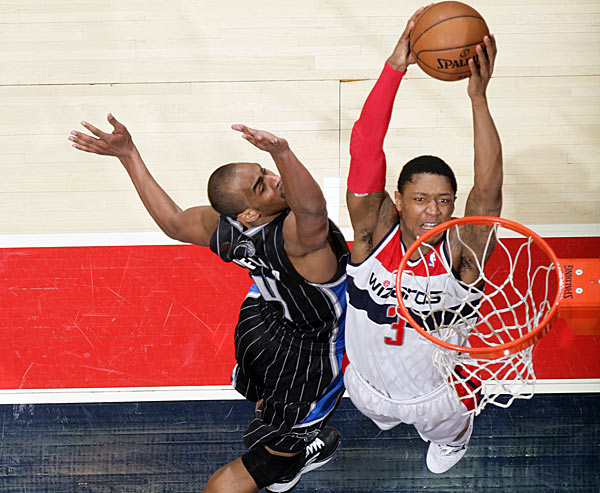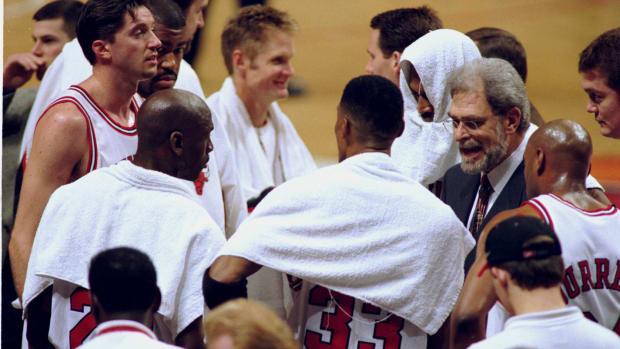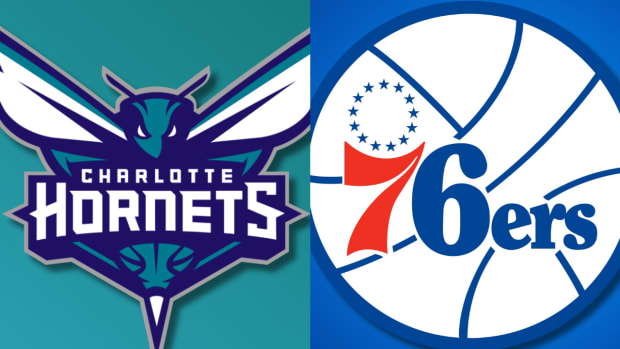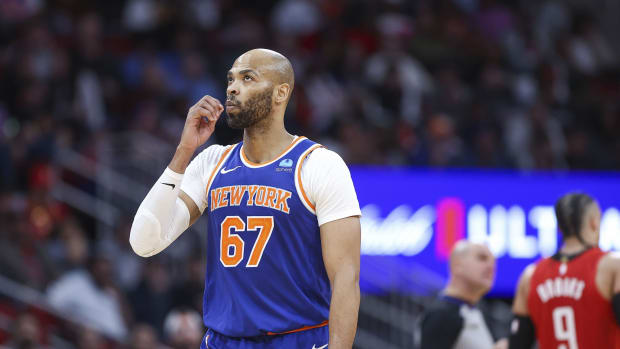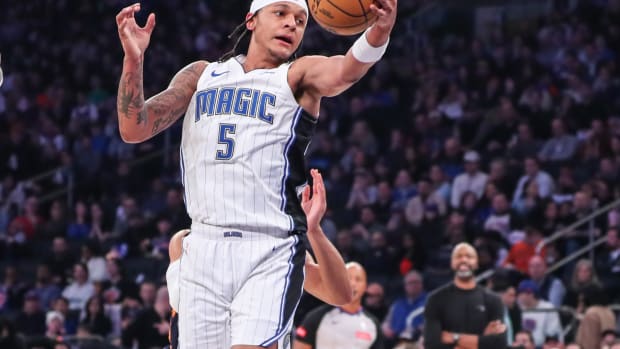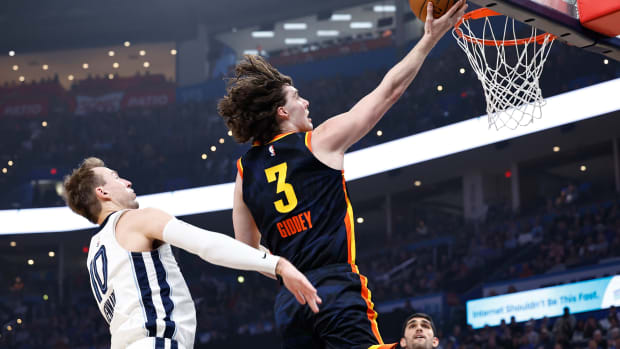Top 100: Notable omissions
Bradley Beal (right) improved as his rookie season progressed. (Ned Dishman/NBAE via Getty Images)
Creating a defined list inevitably leads to snubs, the likes of which run deep with our ranking of the NBA's top 100 players.
In some sense, stopping at 100 is an arbitrary end point. There isn't a dramatic difference between our final pick and those players who narrowly missed the cut, and one could make a compelling case for many of those omitted to claim one of the final spots in our list. Beyond that, there are handfuls of relevant players who are well regarded but noticeably absent, unseated by the sheer number of qualified candidates. The list below is a combination of those two groups -- a collection of 25 notable omissions, though not squarely a queue of those players next in line.
A quick introduction for those not familiar with some of the "advanced" statistical measures used below:
PER (Player Efficiency Rating) -- PER is a per-minute summary of a player's efficiency and performance, weighted so that a league-average player registers a 15. It generally skews in favor of big men and does not account for defensive contributions that don't show up in the box score.
Win Shares -- A metric that uses box score data to estimate the total number of wins a given player contributes. Last season, Win Shares ran on a scale of -1.5 (Michael Beasley) to 19.3 (LeBron James), but only 10 players finished with more than 10.
RAPM (Regularized adjusted plus-minus) -- A variation of plus-minus that compares the on-court impact of every NBA player to a league-average standard (0). The adjustment helps account for much of the statistical noise that exists in raw plus-minus measures.
Arron Afflalo, Orlando Magic
2012-13 stats: 36 MPG, 16.5 PPG, 3.7 RPG, 3.2 APG, 43.9 FG%, 30.0 3FG%
2012-13 advanced stats: 13.0 PER, 2.0 Win Shares, -2.1 RAPM
A five-year, $43 million contract seems to have brought the worst out in Afflalo, a once-ideal complementary player who has lost the precious equilibrium in his game. Since signing that deal with Denver in 2011, Afflalo's defense regressed. His shooting efficiency dropped. The restraint that once underlined his value disappeared, whether because of the perceived need to create more shots for Orlando (which acquired him in the Dwight Howard trade in August 2012) or simply from a standing desire to validate his paycheck. Afflalo still has all the tools necessary to be a fine contributor to a winning team down the line, but over the last two seasons he has seemed too willing to force poor shot attempts while checking out defensively in uncharacteristic fashion. -- Rob Mahoney
Ray Allen, Miami Heat (G, 38)
2012-13 stats: 25.8 MPG, 10.9 PPG, 2.7 RPG, 1.7 APG, 44.9 FG%, 41.9 3FG%
2012-13 advanced stats: 14.7 PER, 5.4 Win Shares, -1.6 RAPM
Imagine, for a moment, how awesome it must feel to know that LeBron James, a player with the talent to eventually challenge Michael Jordan for the greatest-of-all-time title, owes you. And he owes you big. That's life for 2013 Finals hero Allen, whose equalizing step-back corner three-pointer against San Antonio in the closing seconds of regulation of Game 6 will still be shown on highlight reels when James' great-grandchildren are dominating the NBA. That cold-blooded glory moment was why Miami targeted him in 2012 free agency and it helped cover up Allen's mediocre or subpar advanced numbers and his ugly on/off defensive splits (the Heat's defensive rating dropped from 97.2 without him to 103.7 with him). He's an aging shooter with serious limitations almost everywhere else who has found himself the absolutely perfect spot to write a great final chapter. -- Ben Golliver
Tony Allen, Memphis Grizzlies (G, 31)
2012-13 stats: 26.7 MPG, 8.9 PPG, 4.6 RPG, 1.2 APG, 1.5 SPG, 44.5 FG%, 12.5 3FG%
2012-13 advanced stats: 13.2 PER, 6.1 Win Shares, +1.0 RAPM
Allen, an All-Defensive first-team selection for two years in a row, loves locking into a one-on-one perimeter assignment more than anyone else in the league. He has everything you want in a pit-bull-style stopper: toughness, quick feet, good instincts, solid size and intensity. Those credentials would make him a shoo-in as a top-100 player if his offensive game were a little more adequate. Push came to shove during the 2013 conference finals against the Spurs, and Allen's inability to stretch the floor (he attempted only 24 threes in 2,100 minutes last season) limited his playing time and Memphis' chances to keep up in the series, which ended with a San Antonio sweep. Re-signing with Memphis on a four-year deal made all the sense in the world for both player and team, as he's a popular figure locally who helps make one of the league's best defenses go. -- BG
Andrea Bargnani, New York Knicks (F/C, 27)
2012-13 stats: 28.7 MPG, 12.7 PPG, 3.7 RPG, 39.9 FG%, 30.9 3FG%
2012-13 advanced stats: 11.2 PER, 0.1 Win Shares, -2.4 RAPM
Frustration has unfortunately become a constant with Bargnani, who was in and out of the Raptors' lineup over the last few seasons due to injury and seemingly lost all interest in playing even vaguely passable defense. Bargnani seemed to put it all together in a brief, 13-game stretch at the start of the 2011-12 season, when he submitted a solid defensive effort while posting some of the best offensive marks of his career. A nagging calf injury brought that month of good feelings to an unceremonious end, and since then Bargnani has been unable to recapture that level of play. If he can pick back up as a top pick-and-pop option rather than an inefficient shooter, he'll have a chance to do some relative good for the Knicks this season. But rebounding and defense have been such consistent problems that we have little reason to expect improvement -- and thus little reason to otherwise include a one-dimensional player of wavering effectiveness. -- RM
Bradley Beal, Washington Wizards (G, 20)
2012-13 stats: 31.2 MPG, 13.9 PPG, 3.8 RPG, 2.4 APG, 41.0 FG%, 38.6 3FG%
2012-13 advanced stats: 13.6 PER, 3 Win Shares, -2.0 RAPM
To co-opt an often-referenced (over-referenced, really) line from The Wire: "Beal's coming yo! Beal's comin'." The NBA desperately needs some young talent at shooting guard, and Beal looks like a top candidate to lead the next generation. Smooth and composed for his age, Beal's rookie season took off with John Wall's return from a knee injury. With a real point guard to set him up, Beal's shooting and scoring numbers improved dramatically after the season's first two months. The only thing standing between Beal and top-100 recognition is time (and likely not much). -- BG
Andrew Bogut, Golden State Warriors (C, 28)
2012-13 stats: 24.6 MPG, 5.8 PPG, 7.7 RPG, 2.1 APG, 1.7 BPG, 45.1 FG%
2012-13 advanced stats: 13.8 PER, 1.7 Win Shares, +2.0 RAPM
I wish I could trust Bogut's claim that he is now 100 percent healthy, but his availability has been so inconsistent over the last year as to warrant considerable skepticism. Plus, it's not as if Bogut's injury woes were some recent fluke; he's played in barely more than half of his teams' games over the past five seasons, so he comes saddled with a heftier burden of proof than most. Golden State couldn't play him in back-to-back games last season and had to carefully regulate his minutes -- conditions that could be lifted in the coming year, after which a far more favorable ranking might follow.
In full and healthy form, Bogut is an easy inclusion in the top 100. But until he proves he can return to that level, Bogut has been too frequently out of the lineup to be depended on, to say nothing of his now-marginal offensive contributions. His defensive play and rebounding ability are clearly valuable, but Bogut's post game has evaporated in recent seasons (he returned just 0.5 points per play on his post-up opportunities last year, according to Synergy Sports, a dismal mark that ranked 166th in the league) while he's struggled to finish around the basket overall. Hopefully he has better basketball days ahead of him, along with his rightful return to the ranks of the NBA's top centers. -- RM
Nick Collison, Oklahoma City Thunder (F/C, 32)
2012-13 stats: 19.5 MPG, 5.1 PPG, 4.1 RPG, 1.5 APG, 59.5 FG%
2012-13 advanced stats: 13.6 PER, 5.2 Win Shares, +1.5 RAPM
One of the league's consummate glue guys, Collison's ability to take charges and his devotion to respecting the principle of verticality makes him a darling to the basketball purists. His +12.3 net rating, among the best on the Thunder, only reinforces his perception as a "winner" who "does the little things" to put his team over the top. Collison's shot selection is worthy of some praise, too, as he fully understands his limitations and has connected on better than 56 percent for five straight seasons. Last year, more than 68 percent of his shots came from inside the basket area. Cracking the top 100 while playing fewer than 20 minutes a game is next to impossible, especially for a player without significant untapped upside, but letting Collison's contributions go unnoticed somehow feels wrong. "Honorable mention" suits him quite nicely. -- BG
Raymond Felton helped the Knicks win 54 games last season. (Scott Cunningham/NBAE via Getty Images)
Mike Dunleavy, Chicago Bulls (G/F, 32)
2012-13 stats: 25.9 MPG, 10.5 PPG, 3.9 RPG, 1.9 APG, 44.2 FG%, 42.8 3FG%
2012-13 advanced stats: 13.6 PER, 4.4 Win Shares, +0.2 RAPM
Dunleavy is in the same class as a few of the shooting specialists who made the final cut, but he lost out by a matter of degrees. Regardless, he'll give Chicago's offense an added level of flexibility this season, both as a space-clearing shooter (Dunleavy ranked eight in three-point percentage last season) and a much-needed facilitator. His case would be even more compelling if he were a bit closer to average defensively or a bit more dynamic off the dribble, but he still rates as a worthwhile role player set to give a boost to a legitimate title contender. -- RM
Raymond Felton, New York Knicks (G, 29)
2012-13 stats: 34 MPG, 13.9 PPG, 5.5 APG, 2.9 RPG, 1.4 SPG, 42.7 FG%, 36.0 3FG%
2012-13 advanced stats: 15.2 PER, 4.2 Win Shares, +0.8 RAPM
In eight seasons, Felton's PER has hovered between 13 and 17 and he's advanced in the postseason just once. That unexceptional track record would usually allow a player to fly under the radar, but not Felton, whose "conditioning issues" and penchant for brash public boasting attract more media attention than you would expect. It's fair to consider the Knicks' 54-win season in 2012-13 as the high point of his career, as he reached the conference semifinals for the first time and New York rod him hard during the playoffs. He couldn't have asked for a better bounce-back season after a dreadful one-year stopover in Portland in 2011-12. Felton, a drive-and-dish point man who has never been a knockdown three-point shooter, should see an even larger role in 2013-14, thanks to the retirement of Jason Kidd. Felton is who he is at this point, and that's a capable starter who is unlikely to play a defining role in shaping New York's fortunes. -- BG
Eric Gordon, New Orleans Pelicans (G, 24)
2012-13 stats: 30.1 MPG, 17.0 PPG, 3.3 APG, 40.2 FG%, 32.4 3FG%
2012-13 advanced stats: 15.4 PER, 1.1 Win Shares, +0.2 RAPM
Though once tabbed as a potential All-Star, Gordon has since gone about acquiring an assortment of red flags. He's now two seasons removed from high-level basketball, having struggled to stay on the court (Gordon played in just 47 percent of his teams' games over the last three seasons) and stumbled through his playing time on it. His inefficiency, in particular, was alarming; of the 41 players who attempted as many field goal attempts per game as Gordon did last season, only four posted a lower effective field goal percentage. That he posted the worst turnover rate of his career didn't exactly help matters, nor did the lesser defense he played as a result of his diminished lateral movement. If Gordon were better on the court, his injury history and problematicrelationship with the Hornets/Pelicans could be overlooked (to some degree) for the sake of basketball returns. Gordon can get back to playing at that high level, surely, but for the moment is reliable only in his unreliability. -- RM
Celtics forward Jeff Green averaged 12.8 points last season. (Harry How/Getty Images)
Jeff Green, Boston Celtics (F, 27)
2012-13 stats: 27.8 MPG, 12.8 PPG, 3.9 RPG, 46.7 FG%, 38.5 3FG%
2012-13 advanced stats: 15.0 PER, 4.7 Win Shares, -1.7 RAPM
Big-game potential does not make a player great. While Green's 43-point, seven-rebound showing on national television against Miami in March ranks as one of the more memorable performances of the 2012-13 season, that single achievement doesn't undo the months of inconsistency that preceded it. For the bulk of last season, Green waffled as a scorer and didn't make any discernibly positive impact as a defender. He certainly has his nights, but there's not yet much evidence to support the notion that what Green offers is conducive to winning basketball. He's a decent driver, but only in one direction. He's not a horrible defender, but tends to struggle in rotation when playing power forward and otherwise isn't anything resembling a perimeter stopper. Green is a quality three-point shooter in the corners (45.7 percent), but shoots so poorly above the break (31.4 percent) that it acts as a drag on his shooting efficiency. His rebounding numbers are occasionally solid, but by total rebounding percentage (7.4) he stacks up as a disappointment for his position and ranks among the likes of Kyle Korver (7.4) and J.J. Barea (6.9). He's a decent player overall, but Green simply can't be taken at the face value of his best performances. -- RM
Gerald Henderson, Charlotte Bobcats (G, 25)
2012-13 stats: 31.4 MPG, 15.5 PPG, 3.7 RPG, 2.6 APG, 44.7 FG%, 33.0 3FG%
2012-13 advanced stats: 16.4 PER, 3.3 Win Shares, -0.9 RAPM
Henderson was a close cut, done in largely by an absence of definitive strengths. He does a terrific job of filling in the gaps that crop up in any lineup, but there's an unfortunate cost in being only pretty good in so many phases of the game. The lack of a singular, specific talent is unmistakable; Henderson isn't a versatile enough ball-handler to initiate offense more frequently; he shoots well from mid-range but hasn't yet had a league-average season from beyond the arc; he posts up effectively but without the stability to be an offensive focal point; and he rates as a merely good perimeter defender. That potpourri of skills makes him a very useful player, but one who is difficult to define and compare favorably to those in the top 100. -- RM
J.J. Hickson, Denver Nuggets (F, 24)
2012-13 stats: 29 MPG, 12.7 PPG, 10.4 RPG, 1.1 APG, 56.2 FG%
2012-13 advanced stats: 19.7 PER, 6.9 Win Shares, -1.4 RAPM
The Trail Blazers marketed Hickson as "Mr. Double Double" last season, but it was never clear whether they were referring to his points and rebounds or his missed defensive rotations and fruitless attempts at blocking shots. Hickson plugged a gaping hole by shifting from his natural power forward position to the starting center job, a move that helped him put up some of the best numbers of his career. The definition of a one-way player, at least when he's overmatched in the middle, Hickson generally succeeded in seeking out and finishing high-percentage looks in the basket area. The Nuggets rewarded him with a three-year, $16.1 million contract this summer; it wouldn't be surprising if buyer's remorse sets in pretty quickly. -- BG
DeAndre Jordan, Los Angeles Clippers (C, 25)
2012-13 stats: 24.5 MPG, 8.8 PPG, 7.2 RPG, 1.4 BPG, 64.3 FG%
2012-13 advanced stats: 17.2 PER, 6.2 Win Shares, +3.1 RAPM
Jordan is an interesting talent, but it's hard to look too favorably on players whose limited games affect their playing time. Jordan is just one such example, as his disastrous free-throw shooting (38.6 percent!), inability to score when not within arm's length of the rim and shaky positional defense limited him to 24.5 minutes per game for the Clippers last season. He's quick enough to eventually become a much more reliable defender, but the other considerations (range-less offense and misery from the stripe) could well follow Jordan throughout his career. -- RM
Carl Landry, Sacramento Kings (F, 29)
2012-13 stats: 23.2 MPG, 10.8 PPG, 6.0 RPG, 54.0 FG%
2012-13 advanced stats: 17.5 PER, 6.2 Win Shares, -1.6 RAPM
The 2007 second-round pick has quietly put together a nice career, and he was handsomely rewarded with a four-year, $26 million deal from the Kings this summer. A key frontcourt contributor for Golden State in 2012-13, Landry's lack of size at his position hasn't stopped him from generating offense in the basket area and doing work on the offensive glass. He's able to work comfortably and effectively at the high post. His pairing with DeMarcus Cousins will be intriguing to watch. Sacramento ranked 29th in defensive efficiency last season, though, and on that front Landry is unlikely to make much of a dent. His lack ofsize and length have been a persistent problem on the defensive end over the years and his -1.1 net rating was the worst among Warriors rotation players last season. -- BG
Jeremy Lin averaged 13.4 points and 6.1 assists last season. ( Joe Murphy/NBAE via Getty Images)
Jeremy Lin, Houston Rockets (G, 25)
2012-13 stats: 32.2 MPG, 13.4 PPG, 6.1 APG, 3.0 RPG, 1.6 SPG, 44.1 FG%, 33.9 3FG%
2012-13 advanced stats: 14.9 PER, 5.4 Win Shares, +0.4 RAPM
The Man, the Myth, The Linsanity Legend came hurtling back to earth in his first year in Houston. In a rocky 2012-13 season, Lin started slowly, ceded crunch-time minutes on multiple occasions and ended on a whimper because of a chest injury that caused him to miss time during the playoffs. Recapturing his magical run in New York was never really on the table, but Lin admitted that he dealt with sleeplessness and self-doubt as he tried to revise his expectations and make the transition to second fiddle behind James Harden. Rockets general manager Daryl Morey is still selling Lin's upside, citing his point guard's youth and limited NBA experience. It's possible that Lin cracks the top 100 in future iterations of this list, but it's more difficult to envision him as anything more than a slightly above-average starter. -- BG
JaVale McGee, Denver Nuggets (C, 25)
2012-13 stats: 18.1 MPG, 9.1 PPG, 4.8 RPG, 2.0 BPG, 57.5 FG%
2012-13 advanced stats: 20.7 PER, 4.9 Win Shares, +1.2 RAPM
McGee is such a constant presence on highlight and lowlight reels that it would be easy to assume he plays a lot. Last season, that wasn't the case: McGee averaged only 18 minutes and was used exclusively in a reserve role despite an $11 million annual salary. With former coach George Karl and last year's starting center, Kosta Koufos, out of the picture, the middle now belongs to the erratic McGee, for better and worse. His ceiling depends on his ability to play diligent, intelligent team defense possession after possession. -- BG
Andre Miller, Denver Nuggets (G, 37)
2012-13 stats: 26.2 MPG, 9.6 PPG, 5.9 APG, 2.9 RPG, 47.9 FG%, 26.6 3FG%
2012-13 advanced stats: 15.7 PER, 5.4 Win Shares, -0.2 RAPM
Miller's creativity with the ball makes him more than a mere role player, but his marginal scoring and slowed defense at both guard positions leave him as a tough sell for the top 100. There's no shame in being good without being quite good enough; Miller still registers as one of the more helpful passers in the league, singular for both his field of vision and the audacity of his playmaking style. It's that savvy that makes him such a great fit in Denver, equipped to run a fast-breaking, second-unit offense or balance a backcourt alongside Ty Lawson. -- RM
Iman Shumpert, New York Knicks (G, 23)
2012-13 stats: 22.1 MPG, 6.8 PPG, 3.0 RPG, 1.7 APG, 1 SPG, 39.6 FG%, 40.2 3FG%
2012-13 advanced stats: 11.7 PER, 1.9 Win Shares, -1.9 RAPM
Shumpert is the best rapper in the NBA (sorry, Tony Parker). That much we know. Everything else is a bit up in the air after a sophomore year spent getting back up to speed following a 2012 ACL injury. The building blocks of a really nice long-term piece are there: He has the size and mentality to be a quality perimeter defender and he shot 40 percent from three-point range last season (albeit in a fairly small sample). New York increased his role during the playoffs, but soreness in his knee popped up again. Conventional wisdom suggests that he should be significantly more confident and effective in 2013-14, which will mark his second year removed from surgery. Keeping that three-point percentage above league average will go a long way toward raising his individual ceiling. -- BG
Tristan Thompson is a solid rebounder but struggles to finish around the rim. (David Dermer/Diamond Images/Getty Images
Tristan Thompson, Cleveland Cavaliers (F, 22)
2012-13 stats: 31.3 MPG, 11.7 PPG, 9.4 RPG, 1.3 APG, 48.8 FG%
2012-13 advanced stats: 16.1 PER, 5.2 Win Shares, +0.7 RAPM
The No. 4 pick in the 2011 draft is fascinating, and not only because he decided to switch from shooting left-handed to right-handed after two NBA seasons. He was the only player 21 or younger to average at least 11 points and nine rebounds last season. (The only other 23-and-under guys in that category -- Kenneth Faried, Greg Monroe, Nikola Vucevic and DeMarcus Cousins -- were all top-100 selections.) This despite coming to basketball late in life and having a number of obvious holes in his game, including no mid-range ability; a poor 51.4 percent shooting percentage in the basket area last season; a lack of size that leads to his shots getting stuffed back in his face; and horrible free-throw shooting (58.6 percent in two seasons). Does that make him a prototypical "really good numbers on a very bad team" performer, or an overlooked, up-and-coming young big man who is a diamond in the rough? We'll find out soon enough. Another layer of intrigue was added when Cleveland took another Canadian power forward, Anthony Bennett, with the top pick in June. What's the plan there? The one certainty looks to be Thompson's productivity as a rebounder, a skill that will serve him well no matter where the next few years take him. -- BG
Jonas Valanciunas, Toronto Raptors (C, 21)
2012-13 stats: 23.9 MPG, 8.9 PPG, 6.0 RPG, 1.3 BPG, 55.7 FG%
2012-13 advanced stats: 15.6 PER, 3.9 Win Shares, -1.3 RAPM
Valanciunas would be locked into a top-100 spot if our list considered future seasons, but in his current form he barely missed the cut. All the same, there's much to like in his growing game, and it's possible that the second-year center (and reigning Summer League MVP) could improve quickly enough to make this omission glaring in retrospect. -- RM
Greivis Vasquez, Sacramento Kings
2012-13 stats: 34.4 MPG, 13.9 PPG, 9.0 APG, 4.3 RPG, 43.3 FG%, 34.2 eFG%
2012-13 advanced stats: 16.3 PER, 3.8 Win Shares, -0.2 RAPM
Whereas deadly guards such as Stephen Curry and Russell Westbrook project a constant scoring threat, Vasquez's style of play is much less imposing. Opponents can feel safe in giving Vasquez room to operate, knowing full well that his primary inclination is to pass. In fairness, he does so remarkably well; only Chris Paul was responsible for a greater percentage of his teammates' field goals while on the floor last season, and that consistent playmaking was crucial to New Orleans' respectable offensive marks. His skill set just becomes problematic in trying to elevate an offense beyond respectability. Vasquez found ways to score and engage defenders more frequently as the season progressed, but at this point he ultimately only helps an offense to a certain extent -- the magnitude of which is diminished by his defensive drag. -- RM
Dion Waiters, Cleveland Cavaliers (G, 21)
2012-13 stats: 28.8 MPG, 14.7 PPG, 3.0 APG, 2.4 RPG, 41.2 FG%, 31.0 3FG%
2012-13 advanced stats: 13.7 PER, 0.9 Win Shares, -1.7 RAPM
Waiters' primary value lies in creating offense, but he doesn't do so efficiently enough to be a productive influence just yet. That's a bit of a problem in trying to find a place for him in the top 100; Waiters is already working against the deficit that comes with being a young, unschooled defender, not to mention his somewhat limited feel for contributing on offense in anything but the simplest capacity. Add the caveat of his inefficiency and Waiters' case becomes even more flimsy. He's already shown genuine improvement in both his shot selection and driving technique (Waiters has started developing some of the subtle tricks that allow drivers to get to the rim more easily) -- just not to a degree that would account for the shortcomings in his developing game. -- RM
Gerald Wallace, Boston Celtics (F, 31)
2012-13 stats: 30.1 MPG, 7.7 PPG, 4.6 RPG, 2.6 APG, 1.4 SPG, 39.7 FG%, 28.2 3FG%
2012-13 advanced stats: 11.6 PER, 3.1 Win Shares, +1.8 RAPM
Wallace has fallen from being a 2010 All-Star (averaging 18.2 points, 10 rebounds, 1.5 steals and 1.1 blocks) to a player who admitted in April that he "didn't have a clue" what his role was for the Nets after putting up his worst numbers in nine years. Long admired for his energetic bursts, defensive intensity and slashing aggressiveness, Wallace was a shell of himself in Brooklyn and it's not clear how he makes sense in Boston, where he landed as part of the blockbuster Kevin Garnett/Paul Pierce trade. Incredibly, he has three years and $30.3 million remaining on his contract. -- BG
Metta World Peace, New York Knicks (F, 33)
2012-13 stats: 33.7 MPG, 12.4 PPG, 5.0 RPG, 1.5 APG, 1.6 SPG, 40.3 FG%, 34.2 3FG%
2012-13 advanced stats: 12.5 PER, 4.6 Win Shares, +1.2 RAPM
While he isn't without his attractive qualities (useful defense, uniquely physical scoring, decent shooting), World Peace's judgment veers into dangerous territory far too frequently to justify a top-100 ranking. If he were more athletic or capable of playing elite defense (as was the case in the primer of his career), that scatter-brained style would be less of a problem. But right now World Peace is an erratic performer in a trade that values reliability. NBA role players are expected to fulfill a given set of responsibilities in consistent and predictable fashion. World Peace doesn't provide that in any way. -- RM
Statistical support for this post courtesy of Basketball-Reference, NBA.com and Jeremias Engelmann.






























